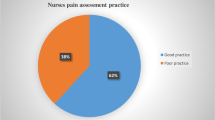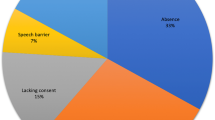Abstract
Background Uncontrolled pain reduces quality of life, delays recovery from surgery and can potentially contribute to the development of chronic pain. Strategies to improve pain management are desirable in view of these detrimental outcomes, yet frequently they are predominately medically based despite nurses playing key roles in pain assessment and analgesic administration. Objective To develop an algorithm-based guidance addressing nurses’ pain assessment and analgesic administration and investigating its impact on quality of pain management. Setting Two orthopaedic units in a university hospital. Method An interdisciplinary expert panel consisting of physicians, nurses and clinical pharmacists developed an algorithm-based guidance in analgesic administration for nurses. The guidance was based on current guidelines addressing the appropriate use of analgesics. In a prospective intervention study, clinical pharmacists acted as independent monitors who assessed nurses’ pain assessment and analgesic administration before (control period: usual care without any further support) and after implementation of the algorithm-based guidance (intervention period). We evaluated patient-nurse contacts for guideline adherence. We predefined guideline adherence (main outcome) as fulfilling all three of the following criteria: (A) nurses’ pain intensity assessment, (B) their assessment of the patients’ need for analgesics, and (C) analgesic administration depending on patients’ individual pain intensity (including choice of prescribed analgesics). Main outcome measure Adherence to pain management guidelines. Results We analysed 706 patient-nurse contacts with 162 patients in the control and 748 contacts with 168 patients in the intervention period. Without support, guidelines were followed in 6 % of the patient contacts. We achieved an increase to 54 % (p < 0.001) after guidance implementation (main outcome). Guideline adherence decreased with rising pain intensity (slope coefficient −0.763, p < 0.001). Conclusion Especially in patients suffering from severe pain, current guidelines were not strictly followed by nurses when administering analgesics. Guideline adherence improved eightfold by implementing an algorithm-based guidance.


Similar content being viewed by others
References
Pavlin DJ, Chen C, Penaloza DA, Polissar NL, Buckley FP. Pain as a factor complicating recovery and discharge after ambulatory surgery. Anesth Analg. 2002;95:627–34.
Macrae WA. Chronic post-surgical pain: 10 years on. Br J Anaesth. 2008;101:77–86.
Correll DJ, Vlassakov KV, Kissin I. No evidence of real progress in treatment of acute pain, 1993–2012: scientometric analysis. J Pain Res. 2014;7:199–210.
Maier C, Nestler N, Richter H, Hardinghaus W, Pogatzki-Zahn E, Zenz M, et al. The quality of pain management in German hospitals. Dtsch Arztebl Int. 2010;107:607–14.
Sommer M, de Rijke JM, van Kleef M, Kessels AGH, Peters ML, Geurts JWJM, et al. The prevalence of postoperative pain in a sample of 1490 surgical inpatients. Eur J Anaesthesiol. 2008;25:267–74.
Chou R, Gordon DB, de Leon-Casasola OA, Rosenberg JM, Bickler S, Brennan T, et al. Management of postoperative pain: a clinical practice guideline from the American Pain Society, the American Society of Regional Anesthesia and Pain Medicine, and the American Society of Anesthesiologists’ Committee on Regional Anesthesia, Executive Committee, and Administrative Council. J Pain. 2016;17:131–57.
DIVS (German Interdisciplinary Association for Pain Therapy). S3-Guideline on Acute, Perioperative and Posttraumatic Pain Management [Internet]. Bonn. Germany; 2007 [updated 2009; cited 2016 March 18]. http://www.awmf.org/leitlinien.html.
Macintyre PE, Schug SA, Scott DA, Visser EJ, Walker SM. APM: SE working group of the Australian and New Zealand College of anaesthetists and faculty of pain medicine. Acute Pain Management: Scientific Evidence. 3rd ed. Melbourne: ANZCA & FPM; 2010.
RNAO (Registered Nurses’ Association of Ontario). Guideline on Assessment and Management of Pain. 3rd ed. [monograph online]. Ontario. Canada; 2013 [cited 2016 March 18]. http://rnao.ca/bpg/guidelines/assessment-and-management-pain.
Benhamou D, Berti M, Brodner G, de Andres J, Draisci G, Moreno-Azcoita M, et al. Postoperative Analgesic Therapy Observational Study (PATHOS): a practice pattern study in 7 central/southern European countries. Pain. 2008;136:134–41.
Berdot S, Sabatier B, Gillaizeau F, Caruba T, Prognon P, Durieux P. Evaluation of drug administration errors in a teaching hospital. BMC Health Serv Res. 2012;12:60.
Gordon DB, Pellino TA, Higgins GA, Pasero C, Murphy-Ende K. Nurses’ opinions on appropriate administration of PRN range opioid analgesic orders for acute pain. Pain Manag Nurs. 2008;9:131–40.
Coyne P, Lyckholm L, Bobb B, Blaney-Brouse D, Harrington S, Yanni L. Managing pain with algorithms: an opportunity for improvement? Or: the development and utilization of algorithms to manage acute pain. Pain Manag Nurs. 2013;14:e185–8.
Gaddis GM, Greenwald P, Huckson S. Toward improved implementation of evidence-based clinical algorithms: clinical practice guidelines, clinical decision rules, and clinical pathways. Acad Emerg Med. 2007;14:1015–22.
Lynch M. Pain as the fifth vital sign. J Intraven Nurs. 2001;24:85–94.
Ene KW, Nordberg G, Bergh I, Johansson FG, Sjöström B. Postoperative pain management—the influence of surgical ward nurses. J Clin Nurs. 2008;17:2042–50.
Manias E, Gibson SJ, Finch S. Testing an educational nursing intervention for pain assessment and management in older people. Pain Med. 2011;12:1199–215.
Sepponen K, Kokki H, Ahonen R. Training of medical staff positively influences postoperative pain management at home in children. Pharm World Sci. 1999;21:168–72.
Chisholm-Burns MA, Kim Lee J, Spivey CA, Slack M, Herrier RN, Hall-Lipsy E, et al. US pharmacists’ effect as team members on patient care: systematic review and meta-analyses. Med Care. 2010;48:923–33.
Jacknin G, Nakamura T, Smally AJ, Ratzan RM. Using pharmacists to optimize patient outcomes and costs in the ED. Am J Emerg Med. 2014;32:673–7.
Strassels SA, McNicol E, Suleman R. Postoperative pain management: a practical review, part 2. Am J Health Syst Pharm. 2005;62:2019–25.
Wang Y, Huang H, Zeng Y, Wu J, Wang R, Ren B, Xu F. Pharmacist-led medication education in cancer pain control: a multicentre randomized controlled study in Guangzhou, China. J Int Med Res. 2013;41:1462–72.
Bertsche T, Askoxylakis V, Habl G, Laidig F, Kaltschmidt J, Schmitt SPW, et al. Multidisciplinary pain management based on a computerized clinical decision support system in cancer pain patients. Pain. 2009;147:20–8.
Hadi MA, Alldred DP, Briggs M, Closs SJ. A combined nurse-pharmacist managed pain clinic: joint venture of public and private sectors. Int J Clin Pharm. 2012;34:1–3.
Apfelbaum JL, Chen C, Mehta S, Gan TJ. Postoperative pain experience: results from a national survey suggest postoperative pain continues undermanaged. Anesth Analg. 2003;97:534–40.
Schiek S, Hildebrand C, Ranft D, Dürrbeck A, Ghanem M, Salis-Soglio G, et al. A cohort study investigating medication management by pharmacists to prevent drug-related problems in pain therapy. Eur J Hosp Pharm. 2015;22:156–60.
van Valen R, van Vuuren H, van Domburg RT, van der Woerd D, Hofland J, Bogers AJ. Pain management after cardiac surgery: experience with a nurse-driven pain protocol. Eur J Cardiovasc Nurs. 2012;11:62–9.
Manias E, Bucknall T, Botti M. Nurses’ strategies for managing pain in the postoperative setting. Pain Manag Nurs. 2005;6:18–29.
Kale A, Keohane CA, Maviglia S, Gandhi TK, Poon EG. Adverse drug events caused by serious medication administration errors. BMJ Qual Saf. 2012;21:933–8.
Oderda GM, Evans S, Lloyd J, Lipman A, Chen C, Ashburn M, et al. Cost of Opioid-related adverse drug events in surgical patients. J Pain Symptom Manage. 2003;25:276–83.
Bristow RE, Chang J, Ziogas A, Anton-Culver H. Adherence to treatment guidelines for ovarian cancer as a measure of quality care. Obstet Gynecol. 2013;121:1226–34.
Baratta JL, Schwenk ES, Viscusi ER. Clinical consequences of inadequate pain relief: barriers to optimal pain management. Plast Reconstr Surg. 2014;134:15S–21S.
Oldenmenger WH, Sillevis PAS, van Dooren S, Stoter G, van der Rijt CC. A systematic review on barriers hindering adequate cancer pain management and interventions to reduce them: a critical appraisal. Eur J Cancer. 2009;45:1370–80.
Ravaud P, Keita H, Porcher R, Durand-Stocco C, Desmonts JM, Mantz J. Randomized clinical trial to assess the effect of an educational programme designed to improve nurses’ assessment and recording of postoperative pain. Br J Surg. 2004;91:692–8.
Dihle A, Bjølseth G, Helseth S. The gap between saying and doing in postoperative pain management. J Clin Nurs. 2006;15:469–79.
Acknowledgments
We would like to thank all physicians, nurses and patients in the participating units for their helpful collaboration. We thank all students who acted as monitors for their support, Benjamin R. Auer for his helpful advice on the statistical analysis, Lena Schrader for language editing and two anonymous reviewers for their highly valuable comments and suggestions.
Funding
This study was supported in part by the Saxony Chamber of Pharmacists.
Author information
Authors and Affiliations
Corresponding author
Ethics declarations
Conflicts of interest
Authors and the acknowledged persons declare that they have no conflict of interest concerning this paper.
Rights and permissions
About this article
Cite this article
Schiek, S., Moritz, K., Seichter, S.J. et al. Standardising analgesic administration for nurses: a prospective intervention study. Int J Clin Pharm 38, 1497–1504 (2016). https://doi.org/10.1007/s11096-016-0311-8
Received:
Accepted:
Published:
Issue Date:
DOI: https://doi.org/10.1007/s11096-016-0311-8




